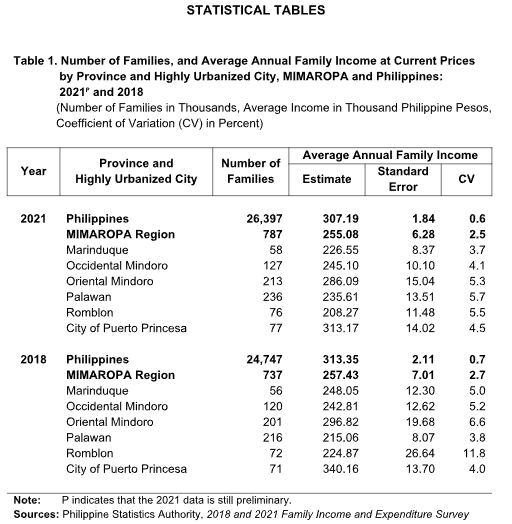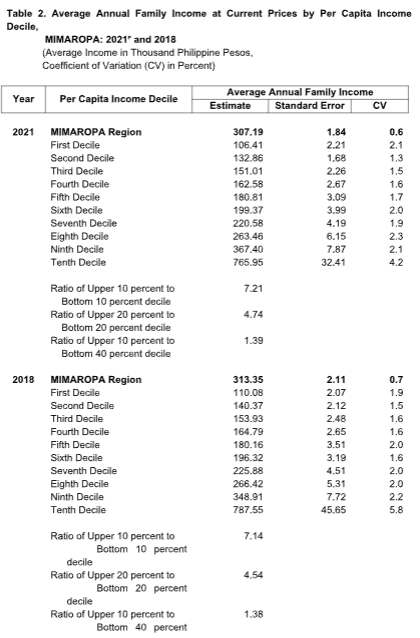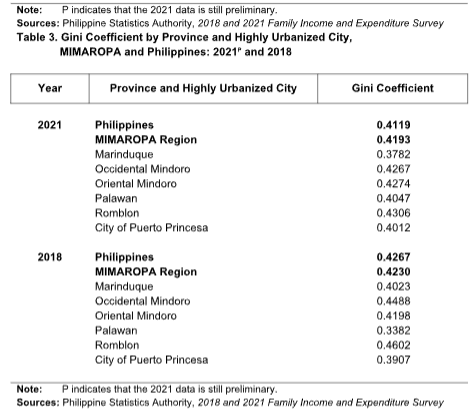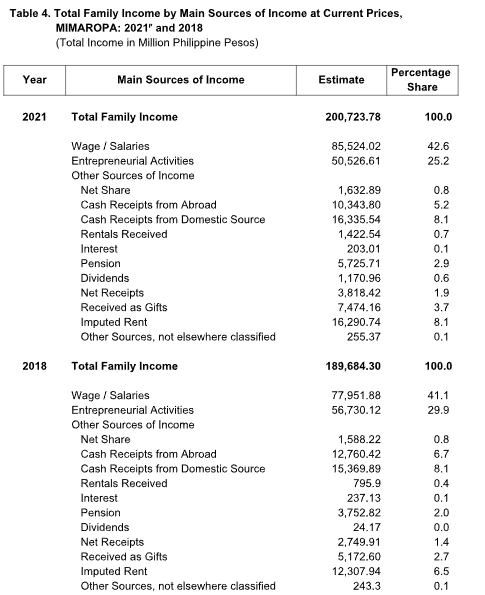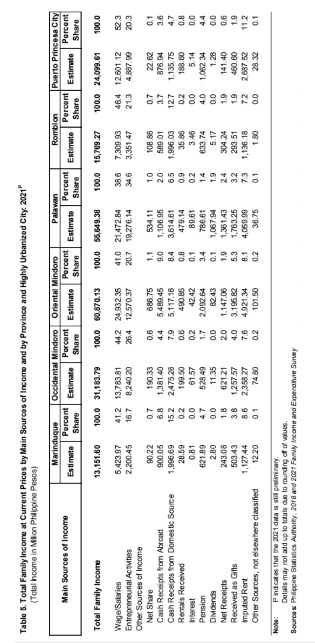
City of Puerto Princesa recorded the highest average annual family income in
MIMAROPA Region
Among provinces and highly urbanized city in the MIMAROPA Region, the
City of Puerto Princesa posted the highest average annual family income at
PhP 313.17 thousand in 2021. This was followed by the province of Oriental Mindoro
with an average annual family income of PhP 286.09 thousand. These domains
posted higher average annual family income compared to the regional average of
PhP 255.08 thousand. Meanwhile, the province of Romblon recorded the lowest
average annual family income in 2021 at PhP 208.27 thousand.
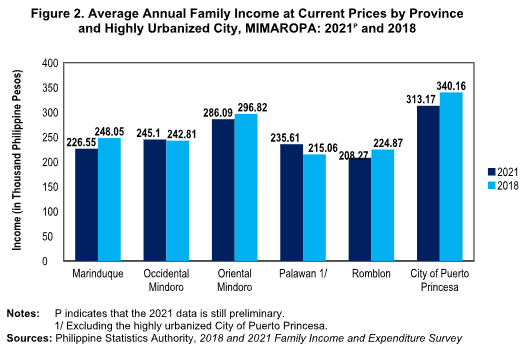
Only Palawan (excluding the City of Puerto Princesa) and Occidental Mindoro
recorded a growth in the average annual family income at 9.6 percent and
0.9 percent, respectively. On the other hand, the highest contraction in the average
annual family income was noted in the province of Marinduque at -8.7 percent. This
was followed by the City of Puerto Princesa at -7.9 percent, Romblon at -7.4 percent
and Oriental Mindoro at -3.6 percent.
Average annual family income contracted among lower income deciles
The average annual family income in all income groups shrank at 0.9 percent in
2021 compared to 2018. Average annual family income in first to fourth income
deciles showed contractions from their levels in 2018. In particular, the annual
income of those families belonging to the first income decile decreased by 3.3
percent. Likewise for the annual income of those families in the second income
decile, third income decile, and fourth income decile had their corresponding decline
by 5.3 percent, 1.9 percent, and 1.3 percent, respectively. On the same trend,
families belonging to the tenth income decile went down by 2.7 percent in 2021
compared to 2018 estimates.
Furthermore, families belonging to the fifth, sixth, and ninth income deciles posted an
increase in their annual income in 2021 by 0.4 percent, 1.6 percent and 5.3 percent
respectively.
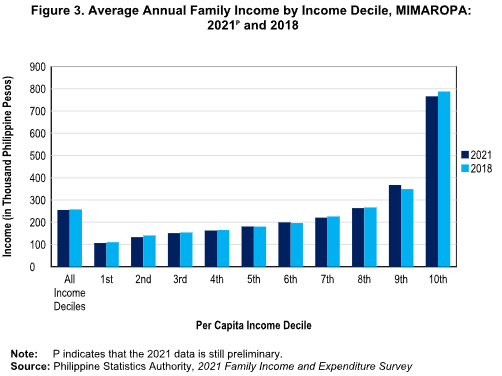
Income disparity contracted in 2021
The total annual family income of the upper 10 percent income group was 7.21 times
as much as that of the bottom 10 percent income group. On the other hand, the total annual family income of the upper 20 percent income group was 4.74 times as much
as the total annual family income of the bottom 20 percent income group.
In 2021, the income inequality in the MIMAROPA Region as measured by the Gini
coefficient 1 was reduced to 0.4193 in 2021 from 0.4230 in 2018. This was slightly
higher than the national figure of 0.4119. This means that in 2021, there was a
higher income disparity among families in the region than in the entire country.
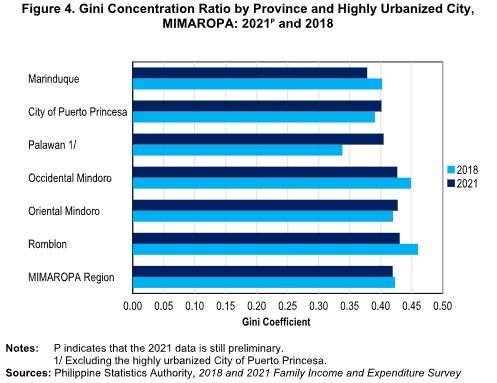
Among provinces in the region, Marinduque had the lowest income disparity with a
Gini coefficient of 0.3782. The highly urbanized City of Puerto Princesa, and the
province of Palawan (excluding the City of Puerto Princesa) and registered Gini
coefficient lower than the regional figure at 0.4012 and 0.4047, respectively.
On the other hand, the province of Romblon registered the highest income inequality
with a Gini coefficient of 0.4306. Two more provinces in the region with less
equitable distribution of income were Oriental Mindoro (0.4274) and Occidental
Mindoro (0.4267).
Wages and Salaries remain as the primary source of total family income in
MIMAROPA
In 2021, wage and salaries remained as the primary source of total family income in
the MIMAROPA Region with a share of 42.6 percent to the total family income. The
share of wage and salaries went up by 1.5 percentage points from 41.1 percent
share to the total family income three years ago. Income from entrepreneurial
activities (25.2 percent), cash receipts from domestic source (8.1 percent), imputed rent
(8.1 percent), and cash receipt from abroad remained (5.2 percent) to be the top
contributors to total family income.
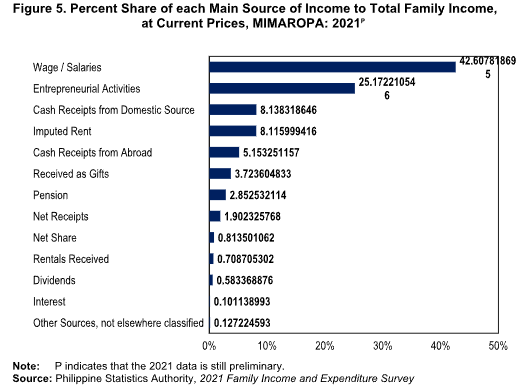
Likewise, wages and salaries were the primary source of income in all provinces and
highly urbanized city in the MIMAROPA Region. Among all domains, the City of
Puerto Princesa posted the highest percentage share for wages and salaries among
other sources of income, accounting for 52.3 percent. Romblon followed with wages
and salaries constituted 46.4 percent of the province’s total family income.
Meanwhile, the lowest share of wages and salaries was noted in Palawan (excluding
the City of Puerto Princesa) at 38.6 percent of the province’s total family income.
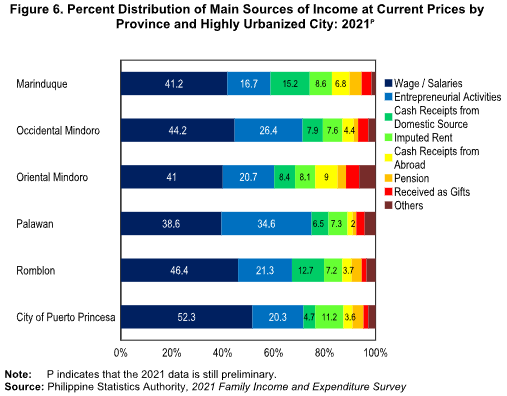
Entrepreneurial activities and cash receipts from domestic sources came in second
and third spot in all provinces and highly urbanized city in the region. Among all
domains, Palawan (excluding the City of Puerto Princesa) got the highest
contribution of entrepreneurial activities to the provincial total family income at 34.6
percent while the least percentage share was in Marinduque at 16.7 percent.
Meanwhile, cash receipts from domestic sources got the highest share to the
provincial total family income in Marinduque at 15.2 percent and was followed
closely by Romblon at 12.7 percent share.
Completing the top five contributors to the provincial total family income were
imputed rent, and cash receipts from abroad. Among domains in the region, the
imputed rent had the greatest contribution to the total family income of the City of
Puerto Princesa at 11.2 percent, while cash receipts from abroad provided the
biggest share to Oriental Mindoro’s total family income.
Majority of families were engaged as wages/salary workers
In 2021, an estimated 610 thousand families in the MIMAROPA Region were
engaged as wages/salary workers, an increase of 4.4 percent compared to 584
thousand families in 2018. This is evident in the fact that the total family income in
the region was primarily sourced from wages and salaries in 2021.
Moreover, income from entrepreneurial activities by 564 thousand families in the
region came in second place. This was an increase of 11.1 percent compared from
508 thousand families three years ago.

Furthermore in 2021, about 665 thousand families in the region were engaged in
other sources of income such as cash receipts from domestic sources, imputed rent,
cash receipt from abroad, pension, received as gifts, net receipts, net share, rentals
received, dividends, interest, and other sources not elsewhere classified. This
number of families went up by 4.7 percent from the 2018 level of 635 thousand
families.
TECHNICAL NOTES
The 2021 Family Income and Expenditure Survey (FIES) is a nationwide
survey of households undertaken every three years. It is the main source of data on
family income and expenditure, which include among others, levels of consumption
by item of expenditure as well as sources of income in cash and in kind. The results
of FIES provide information on the levels of living and disparities in income of Filipino
families, as well as their spending patterns.
The 2021 FIES enumeration was conducted twice – the first visit was in July
2021 covering the first semester (January to June 2021) as the reference period; the
second visit was in January 2022 with the second semester (July to December 2021)
as reference period. The same set of questions is asked for both visits.
This survey adopted the 2013 Master Sample Design, with a sample size of
approximately 180,000 sample households.
The number of families for the 2021 FIES was estimated using the household
population projections-based on the household population counts from the 2015
Census of Population (POPCEN 2015).
Since 2012 FIES, the survey adopted the 2009 Philippine Classification of
Individual Consumption According to Purpose (PCOICOP). The 2009 PCOICOP is
the first standard classification of individual consumption expenditure in the country.
The standard error can be used to calculate confidence intervals within which
the true value for the population can reasonably be assumed to fall. For example,
for any given statistic calculated from a sample survey, the value of that statistic will
fall within a range of plus or minus two times the standard error of that statistic in
95 percent of all possible samples of the same size and design.

